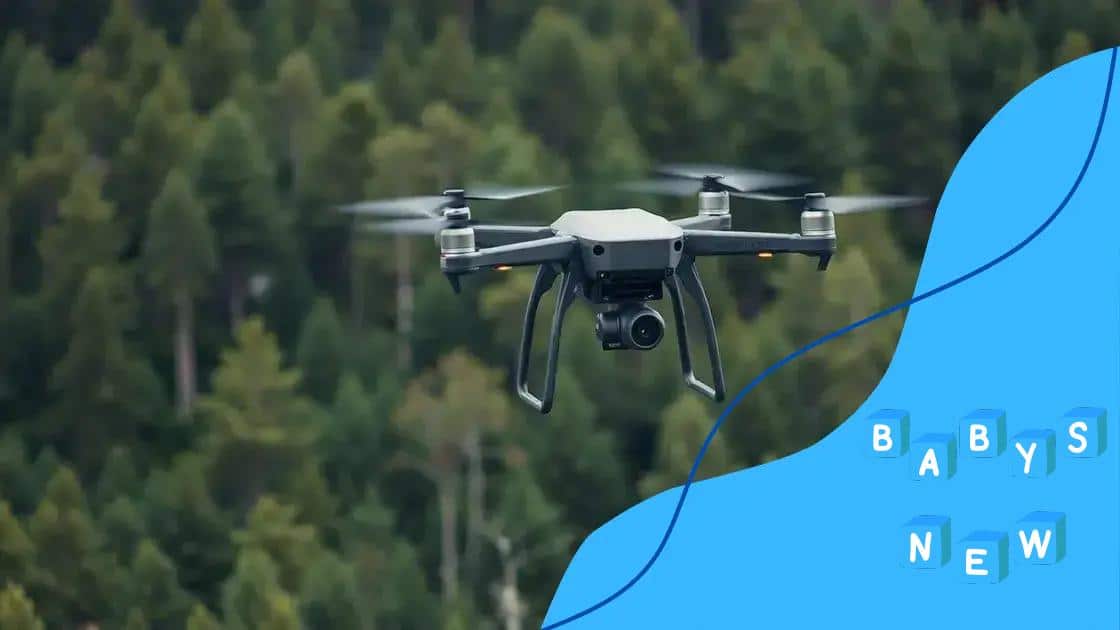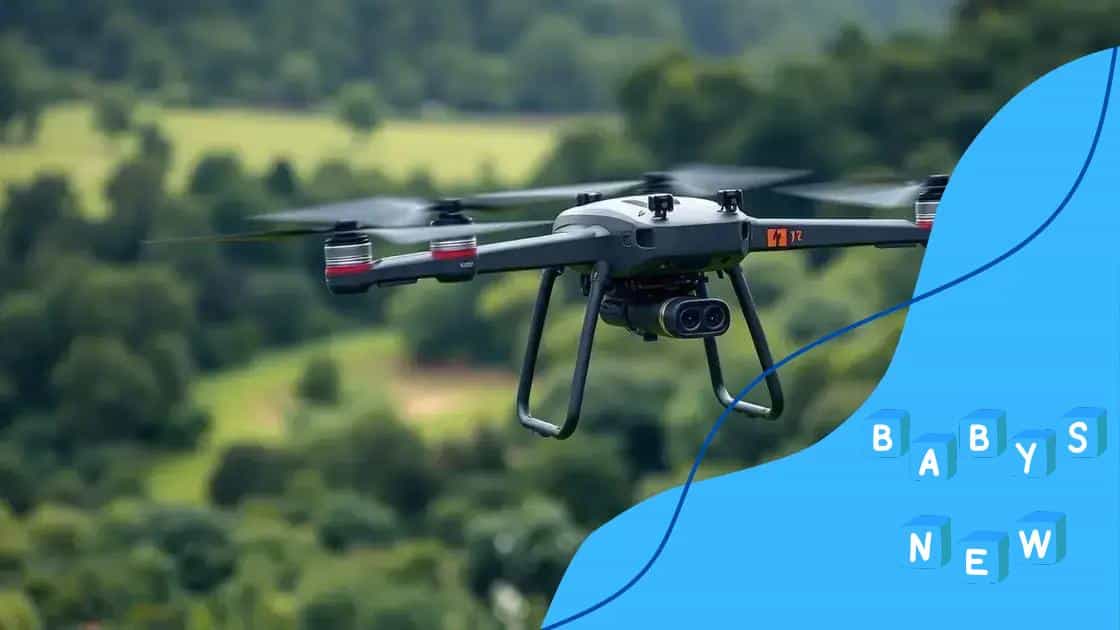Drone use in environmental monitoring: a game changer

Drone use in environmental monitoring enhances data collection through advanced sensors and AI, allowing for rapid analysis and decision-making while facing challenges like regulatory compliance and weather impacts.
Drone use in environmental monitoring is quickly becoming essential for scientists and conservationists. These high-tech tools provide new insights into environmental changes and help safeguard ecosystems. Curious about how they work? Let’s dive in!
Understanding drone technology
Understanding drone technology is crucial as it plays a significant role in various fields, especially in environmental monitoring. Drones, or unmanned aerial vehicles (UAVs), are equipped with advanced features that allow them to gather data quickly and efficiently.
These flying machines come with various sensors and cameras that capture high-resolution images and videos. This capability means data can be collected from areas that are difficult or dangerous for humans to reach. The technology behind drones has advanced rapidly, making them more accessible and effective in their functions.
Key Components of Drone Technology
Drones are composed of several essential components that work together to ensure smooth operation:
- Flight Controller: This acts as the brain of the drone, processing data from sensors and controlling movement.
- GPS System: It helps the drone navigate and maintain its position during flight.
- Sensors: Various sensors like LiDAR and cameras collect data for environmental monitoring.
- Battery: A powerful battery allows drones to fly for extended periods, enabling them to cover large areas.
Another remarkable aspect of drone technology is the software that controls them. Pilots can program flight paths and automatically collect data, making monitoring tasks less labor-intensive. Additionally, advancements in artificial intelligence allow drones to analyze the data they collect in real time.
Applications of Drones
Drones are not just toys; they serve important purposes across different sectors. In environmental monitoring, they can:
- Survey wildlife habitats without disturbing the animals.
- Monitor deforestation and land use changes over time.
- Track natural disasters and assess the damage.
- Evaluate air and water quality in remote locations.
As technology continues to evolve, the use of drones will likely expand. They offer a unique advantage in providing precise data for environmental protections and research.
Applications of drones in environmental monitoring
The applications of drones in environmental monitoring are vast and innovative. These advanced tools are transforming the way we gather and analyze environmental data, leading to more informed decisions in conservation and management.
Drones can cover large areas quickly, making them ideal for monitoring ecosystems, wildlife, and environmental changes. They help scientists and environmentalists gather necessary data that would be challenging through traditional methods.
Key Uses of Drones
Here are some key applications where drones are proving to be invaluable:
- Wildlife Tracking: Drones are often used to track animal movements without disturbing their natural behavior. This helps protect endangered species and study migration patterns.
- Forest Management: Monitoring forest health is easier with drones, which can assess tree density, health, and biomass, helping in forest management and conservation.
- Pollution Monitoring: Drones can survey areas affected by pollution, such as oil spills or chemical leaks, providing real-time data for quick response.
- Mapping Natural Resources: Drones facilitate the mapping of resources like water sources and vegetation cover, contributing to sustainable management practices.
Additionally, the imagery captured by drones can be analyzed to create detailed maps and models. This data is crucial for understanding changes in land use and detecting illegal activities such as poaching or deforestation.
Advantages of Using Drones
Using drones offers several advantages over traditional monitoring techniques. They are:
- Cost-effective: Drones reduce the costs associated with manned flights and field surveys.
- Safe: They allow monitoring in areas that are too dangerous or inaccessible for humans.
- Efficient: Drones can quickly cover vast areas, providing timely data for urgent environmental assessments.
As more organizations adopt drone technology, its applications in environmental monitoring will continue to evolve, paving the way for smarter, more effective conservation strategies.
How drones are transforming data collection

How drones are transforming data collection is a topic of great importance in today’s technology-driven world. These flying robots have changed how we gather information about the environment, wildlife, and natural resources.
Drones equipped with advanced sensors are capable of capturing a large amount of data quickly. This makes them an efficient tool for researchers and environmentalists who need accurate and timely information. Instead of spending days or weeks gathering data on the ground, drones can accomplish the same task in just a few hours.
Benefits of Drone Data Collection
Using drones for data collection offers several key benefits:
- Speed: Drones can gather data over large areas swiftly, providing immediate insights.
- High-resolution imagery: Equipped with cameras, drones capture detailed images that help in monitoring changes in landscapes.
- Access to hard-to-reach areas: Drones can fly over rugged terrain, flooding, or dense forests where traditional methods are difficult.
- Cost-effective solutions: Reducing the need for extensive manpower and equipment makes drone data collection more affordable.
As drones become more advanced, their ability to collect data is expanding. They now can analyze temperature, humidity, and air quality, further enhancing our understanding of environmental conditions. This capability allows for better decision-making in environmental management.
Case Studies of Drone Data Collection
Various organizations have already seen the benefits of drones in data collection. For example, conservation groups use drones to monitor wildlife populations by tracking movements without human interference. Agricultural sectors utilize drones to assess crop health and yield predictions through aerial imagery, helping farmers make informed choices on treatments and harvesting.
Furthermore, government agencies deploy drones for disaster management, analyzing damage assessments after events like hurricanes and floods. This information is critical for planning recovery efforts and providing immediate assistance.
Challenges faced in drone operations
Challenges faced in drone operations are important to understand, especially as the use of drones becomes more widespread in various industries. While these technologies offer many advantages, they also come with several hurdles that can impact their effectiveness.
One significant challenge is regulatory compliance. Different countries and regions have various laws governing drone usage, including airspace restrictions and licensing requirements. Navigating these regulations can be complex and time-consuming.
Common Issues Encountered
Several common issues affect drone operations:
- Weather Conditions: Wind, rain, and other weather factors can impede drone performance and safety. Flying in poor weather can lead to accidents or loss of control.
- Battery Life: Drones are limited by their battery capacity, which affects how long they can operate before needing a recharge. This limitation can hinder long-duration missions.
- Privacy Concerns: Drones equipped with cameras can raise privacy issues, leading to public concerns and resistance to their use.
- Technical Failures: Mechanical issues or software bugs can occur, potentially causing drones to malfunction during operations.
Additionally, there are safety concerns related to flying drones near populated areas. The risk of collisions with other aircraft or unexpected obstacles poses significant dangers. As drones are increasingly used for critical tasks, ensuring safety measures and proper training for operators is vital.
Future Considerations
As drone technology continues to evolve, addressing these challenges will be essential. Research and development are focusing on creating drones with longer battery life, better weather resistance, and advanced navigation systems. By overcoming these challenges, the potential of drones in various fields can be fully realized, enhancing their contributions to environmental monitoring and beyond.
Future trends in drone technology for monitoring
Future trends in drone technology for monitoring promise to revolutionize how we collect and analyze data. As technology advances, drones are becoming more capable, efficient, and versatile.
One trend is the integration of artificial intelligence (AI) with drone systems. AI enhances data processing, allowing drones to analyze information on-the-fly. This means quicker insights and more informed decision-making in environmental monitoring.
Emerging Technologies
Several emerging technologies are shaping the future of drone monitoring:
- Improved Sensor Technology: New sensors for measuring air quality, temperature, and humidity will provide more detailed environmental data.
- Autonomous Flight Capabilities: Advanced navigation systems will enable drones to operate autonomously, reducing the need for human intervention and improving efficiency.
- Swarm Technology: The ability for multiple drones to work together will allow for coverage of larger areas and more comprehensive data collection.
- Energy Efficiency: Innovations in battery technology and energy sources, such as solar power, will extend flight times and reduce operational costs.
Another significant trend involves advancements in regulatory frameworks. As drone use grows, governments are developing more comprehensive regulations to ensure safety while allowing innovative applications. This adaptability will facilitate smoother integration of drones into various fields.
Applications in Various Fields
The anticipated advancements in drone technology will impact various sectors, including agriculture, disaster response, and wildlife management. In agriculture, drones will monitor crops more effectively, improving yield predictions and resource management. During disasters, drones can quickly assess damage in unsafe areas, providing vital information for aid efforts.
In wildlife management, enhanced drone capabilities will allow for better monitoring of animal populations and habitats, supporting conservation efforts. There is a growing recognition of the potential for drones to revolutionize how we interact with our environment.
FAQ – Frequently Asked Questions about Drone Use in Environmental Monitoring
What are the main advantages of using drones for environmental monitoring?
Drones offer rapid data collection, access to hard-to-reach areas, and high-resolution imagery, making environmental monitoring more efficient.
How does AI enhance drone capabilities in data analysis?
AI allows drones to process and analyze data in real-time, providing quicker insights and better decision-making for environmental management.
What challenges do drones face in environmental monitoring?
Challenges include regulatory compliance, weather impacts, privacy concerns, and technical failures that can affect their operation.
What future trends can we expect in drone technology for monitoring?
Future trends include improved sensors, autonomous flight capabilities, and swarm technology, which will expand drones’ roles in various sectors.





